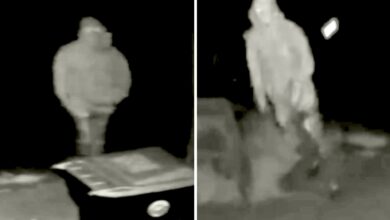Local supermarkets keep Food Bank going
As I pushed the shopping cart toward the Fort Bragg Food Bank bobtail truck parked behind Safeway, it jostled and a plastic container of deep, dark brown chocolate cookies jettisoned out and scattered on the asphalt.
They looked delicious and I apologized for the waste to the man I was supposed to be helping, Earl House, who drove the bobtail on Friday morning.
“Don”t worry — it happens,” he said.
I scooped the cookies up, tasting one of the crisp yet gummy creations that I think was on top of another one, and then proceeded to take the rest to the trash.
“You could just leave them on top, for the birds,” said House.
Those sleek, bug-eyed blackbirds were lurking a few feet away and as we drove away I could see they did become the final consumers of that tray of Food Bank food.
Last week I learned quite a bit about how far donated food in our town can go as I rode along with the truck drivers” who pick up food for the Food Bank.
I learned just how much hinges on three aging trucks that will soon need replacement, and on the gifts of the two big supermarkets in town.
Such local donations are more critical than ever, due to cutbacks in government programs. The New York Times reported this month that food banks across the country are having their worst year since they originated. Food banks, once only an inner-city feature, arose in the 1970s as America”s hunger problem increased and previously-unknown issues like chronic homelessness appeared on the scene.
A little history
The Food Bank was started in Fort Bragg in 1979 by a group of local women, many of whom are still active in community endeavors. The Fort Bragg group managed the Greenwood Trucking Co. and bought food in large quantities for distribution through a co-op store at 650 N. Main St., in Fort Bragg. The Mendocino-Lake Food and Nutrition Program became a 501(c)(3) non-profit corporation in March 1979 while at that location. A popular Food Bank cookbook was also developed.
In June 1981, the program moved offices to 242 N. Harrison St. where it shared space with the CAARE Project. They worked with others in Del Norte, Humboldt, Lake and Mendocino counties to establish a Food Stamp Outreach program.
The gap between rich and poor has widened since 1981, and funding for food banks increased over that time. In June 1982, the local food bank moved to 360 N. Corry St. A small storage shed became an office, and the program came to be known as the Fort Bragg Food Bank. As more poor people and more commodities came through the front door, it outgrew the site and in 1984 moved again to 900 N. Franklin St. The Food Bank ceased having any connection with Lake County, and so in 1988 the program became officially the Mendocino Food & Nutrition Program, Inc. In May 1993, the Food Bank moved into its permanent home at 910 N. Franklin.
Increasing demand, diminishing funds
Now cutbacks are hitting food banks all over, and they are having more trouble than ever filling their longer lists of hungry people.
“The Emergency Food Assistance Program [EFAP] is sending us less quantity of USDA commodities this year,” said Nancy Severy, executive director of the Fort Bragg Food Bank. “This means we have to find other sources of food or funding to buy food and keep the same level of weekly food distribution to our client families.”
“Right now EFAP funding for next year is in limbo — it”s part of the Farm Bill pending in Congress,” Severy said. “Until the bill passes we won”t know if the program will be cut. We just keep our fingers crossed (and write to our congressmen!). As EFAP is a major source of funding, cuts to this program could be disastrous for us.”
Food bank operators nationwide are lobbying for passage of a farm bill currently stalled in the U.S. Senate. The bill would raise emergency aid for food banks to $250 million a year, from $140 million. That figure has remained steady since 2002, while other programs have been cut.
A daily gift
On my ride-along last Friday, I watched House pack the big truck full, with cartload after cartload of gifts from Harvest and Safeway.
I felt one of the town”s two biggest stores must give more than the other. But I was amazed at how equal the gifts were on the two days I observed. Both gave produce, bakery items and dairy products, all of which looked fresh and while near, were not past their expiration dates.
Both House and Lance Nelson, who runs the warehouse and drives the truck two days a week, say the big hauls from the two stores each weekday are the backbone of the fresh food that clients like so much.
“It”s amazing how when one is short, the other seems to have more. If one gives a lot of dairy, I can pretty much know the other one will give a lot of fresh produce,” said House.
I eyed a load of Clover heavy whipping cream from Harvest. Some of the store”s specialty items are beloved by clients. The store makes gourmet sandwiches in its deli, which clients await eagerly. I know how good those sandwiches are, having helped make them as a job developer.
A petulant water truck driver blocks our way behind Harvest and we have to back out, a tricky move. I used to drive tractor-trailers myself and ask House about this violation of the trucker”s code.
“He does that every time he comes in. He”s the only one. I just try not to stress. It will come back to him,” he said.
With visits to Thanksgiving Coffee, D”Aurelio”s Pizza and the Mendocino Cookie Company, my rounds with House were an aromatic pleasure cruise.
House, known for his firewood sales business, says the part-time job at the Food Bank is hard work but has rich rewards.
“I get to do something good for people, and I get treated great and thanked by people at every stop,” he said.
House, a powerful man built like his name, moved more than a ton of food that Friday from the two grocery stores and a few bags at the others stops. The process of gathering and distributing the food is a much bigger one than I had imagined. A crew of volunteers, along with House and Nelson, his boss, unload the truck quickly.
Nelson, a wiry salmon troller for three decades, has no trouble with the heavy labor and moves at a frenetic pace, moving pallets, taking down government staples from the top shelf, getting frozen items from the big walk-in freezer and moving the food to the public area.
But even with all that it”s a big job to get the food to the clients while it is still fresh. And all the efforts are just never quite enough to meet the need.
Food Bank
can stretch cash
“While we receive food and funding through various government programs and other grants,” said Severy. “It”s not enough to cover all our expenses for food and for basic operations. We are committed to providing food on a weekly basis to our clients. A good deal of the donated cash we receive goes toward providing each Food Bank client family with a bag of staple foods each week (beans, rice, pasta, canned fruits and vegetables, etc.).”
The Food Bank gets foods from local farmers, donation barrels, special efforts like the newspapers” annual Season of Sharing fund drive, and unpredictable government programs.
“America”s Second Harvest program, a significant source of really low cost food to us, seems to have less quality food available to us than in past years,” Severy explained. “This means we have to find other sources of food — usually at a higher cost to us.”
What clearly is needed the most is cash.
“Cash donations are great, because to a certain extent we can really leverage these funds by obtaining food at a very low cost through the America”s Second Harvest program and through the Redwood Empire Food Bank in Santa Rosa. Cash donations give us a lot of flexibility,” Severy said.
In 1993, the Fort Bragg Food Bank took over a 4,500-square-foot warehouse in Fort Bragg”s only true industrial zone on North Franklin Street, surrounded by factories, warehouses and yards for state agencies.
The organization obviously has spent more on feeding the hungry than on sprucing up the tired building, which the Mendocino Food & Nutrition Program owns free and clear.
“We are still challenged by inadequate freezer space and are talking with the city about possibly getting funding through a CDBG grant for a larger freezer,” Severy said.
“We also have to meet our basic operational costs — modest wages for a small paid staff, insurance, supplies, truck fuel and maintenance of our warehouse and aging fleet of two delivery trucks.”
Experts attributed the nationwide food bank shortages to an unusual combination of factors, including rising demand, a sharp drop in federal supplies of surplus farm products, and tighter inventory controls that are leaving supermarkets and other retailers with less food to donate.
One reason for the decline in food to food banks is super discount grocery stores, which take food that conventional grocery stores will no longer sell and which used to go to food banks, the New York Times reported. As there are no such stores on the coast, that doesn”t impact here.
Over the next two weeks, I plan to look at how the churches, non-profits and other feeding programs complement the Food Bank”s efforts, and we will meet Food Bank volunteers and staff along with its board of directors.
Season of Sharing
The goal of the Advocate-News and Mendocino Beacon”s Season of Sharing fund drive is to raise a substantial chunk of money that the Food Bank can draw on year-round, not just during the holidays when donations tend to flow most freely. This year”s target is $20,000.
The Community Foundation of Mendocino County administers the Season of Sharing free of charge as a courtesy to the newspapers, so every cent goes to the Food Bank. Checks should be addressed to the Community Foundation of Mendocino County (CFMC), and mailed to Advocate-News, P.O. Box 1188, Fort Bragg, 95437, or dropped by the newspaper office, located at 450 N. Franklin St. If you have any questions about the fund drive, call the Advocate-News at 964-5642. The fund-raiser runs through Dec. 31.
Donors” names are printed each week, unless they ask to remain anonymous. As of Wednesday, the drive has reached $8,715. This week”s donors are Sharon Hansen, Janice Boyd, Janice and Steve Walker, William and Wilma Follette, Art”s Appliance Repair (Arthur Owens), Patricia Frobes and Richard Smith, B. Boyd and Mary Kay Hight, Little River Inn, J. R. Harrison, Gilbert and Marian Roden, Michael and Ruth Dell”Ara, Wallace Conroe, Fred White, Gin Paul Kremen, and there were two anonymous donations.




